HEIRLOOM ART — Unveiling the Legacy of Raja Ravi Varma!
The Painter Prince — Raja Ravi Varma is considered one of the pioneers of modern Indian art. Born in 1848 in the southern state of Kerala, he was a multifaceted personality, who was not only an excellent painter but also a teacher, philosopher, and visionary. He was the first Indian artist to introduce the western style of painting to the Indian masses and paved the way for the fusion of Indian and western art styles.
Distinguished and duly regarded for his contribution to Indian art, his vast range of paintings and prints are legendary. His art was a reflection of the Indian ethos & culture that depicted Indian mythological tales, religious themes, and portraits of Indian royalty and aristocracy. Known for his use of vibrant colors, fine brushwork, and the ability to capture the essence of Indian beauty, his name is revered in the Indian art industry.
His efforts to modernize Indian iconography with the use of European techniques & aesthetics and extraordinary talent for realism gave deities & characters from the great Indian epics (The Ramayana & The Mahabharata) faces that were relatable to the common folk of the time.
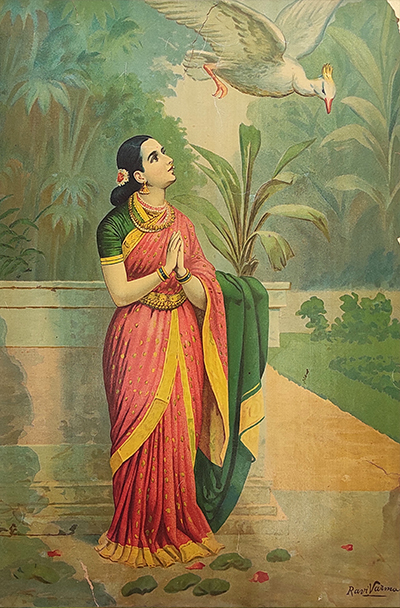
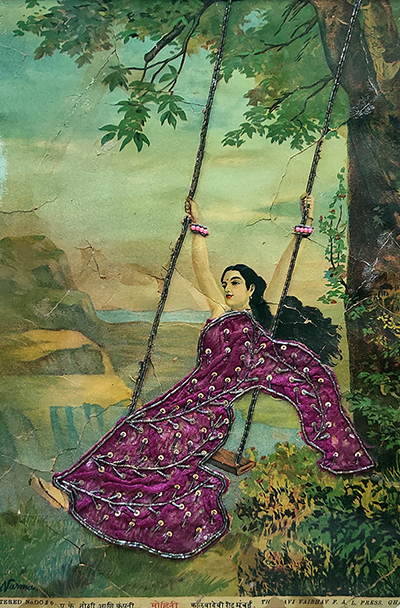
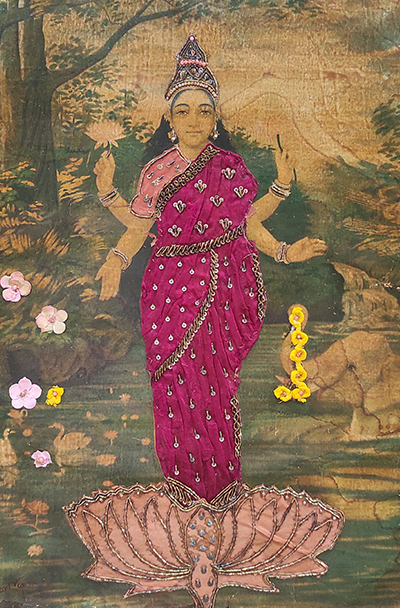
The establishment of the Ravi Varma Fine Arts Lithographic Press democratized God & art. This started a movement of coloured lithographs in the country, where people were able to own these reproductions and fine art became a part of everyone’s daily life!
His collaborations with the German printer, Fritz Schleicher, and several exhibitions overseas catapulted his work worldwide, giving Indian art International reach like never before. Raja Ravi Varma’s paintings of beautiful sari-clad women received immense recognition in the west and his depictions of Indian women drew such appreciation that a beautiful woman would often be described as looking “as if she had stepped out of a Varma canvas.”
His body of work conquered the human heart, highlighted the emotion of devotion, and brought Indian aesthetics to the forefront. His impact is still felt after 150 years, where every generation takes something away and makes it their own. From creating films and digital art to diving into the epics and creating modern-day literature or even apparel!
This impact is the touchstone of our exhibition, where we celebrate the history, the culture, the ever-evolving relevance, and the might of the legacy that has been left behind by the great Indian artist — Raja Ravi Varma!
Without further ado, we bring to you:
Heirloom (noun): a valuable object that has belonged to a family for several generations.
No word other than ‘heirloom’ can describe the legacy that has been left behind by Ravi Varma. It is so finely stitched into the tapestry of Indian art and culture, that it belongs to the Indian people and speaks to their sensibilities in a way that is nostalgic and prideful.
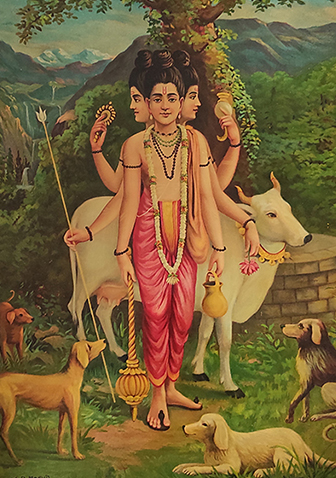
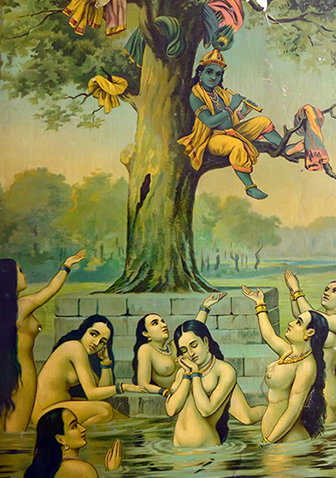
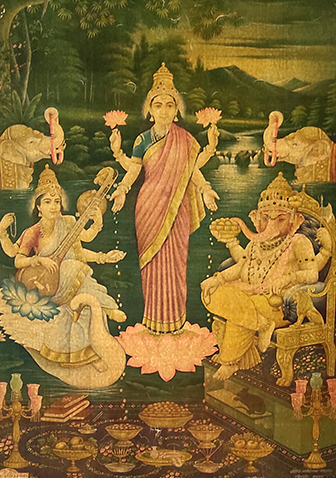
The exhibition — HEIRLOOM ART — Unveiling the Legacy of Raja Ravi Varma! — aims to highlight the enduring legacy of the Painter Prince and its deep impact on Indian art and culture. A display like never before, the exhibition will showcase over 200 works by the iconic artist! The carefully curated selection is the result of working closely with aficionados and collectors over the last 3 years to bring a collection that translates the immense body of work that Raja Ravi Varma produced in his lifetime.
This diverse collection features oleographs that showcase the artist’s exceptional skill in capturing the essence of Indian mythology and aristocracy through composition and fine detailing. Brimming with excerpts from the epic tale of Ramayan to the mythical stories of yore, the exhibition will transport the viewer to a forgotten world of grandeur. The oleograph collection is accompanied by a brief re-telling of their significance & cultural context, helping a younger audience to connect with the works as well. Many of the oleographs from this collection are presented in their 100-year-old original teak frames that add to their exclusivity and value, making them rare and desirable for collectors and art enthusiasts.
The collection is home to several famous works by the artist that have continuously gained favour from many over the years. When browsing through the collection, look out for ‘Hamsa Damyanti’, whose original painting is acclaimed as RRV’s masterpiece. You will notice an opulent setting where she is immersed in conversation with a golden-plumed swan that speaks to her of her beloved, King Nala. The softness depicted in her eyes and her leaning posture all indicate that she is fully engrossed in the interaction.
You may also stop to admire the youth & sheer abandon depicted in ‘Mohini’, who was said to be a temptress that would haunt young and unmarried men. She appears in a white sari with loose hair, playing on a swing in a solitary meadow. This is one of RRV’s most popular subjects.
‘Lakshmi’, the goddess of wealth & prosperity is particularly known for its divine depiction and significance. She will appear in her purest form, standing on a blooming pink lotus, offering benedictions, boons, and protection — representing the world’s luxuries.
Your sensibilities will be piqued by the simplicity in which the Lord of lords — ‘Dattatreya’ is depicted. His form, the fusion of the three trinities — Brahma, Vishnu, and Shiva appears with three heads, and six hands in a village scene. The juxtaposition of Dattatreya’s divine appearance in the humble backdrop makes the composition interesting and unique.
A popular theme for Raja Ravi Varma was the depiction of Lord Krishna’s playful childhood and teasing demeanor. In ‘Krishna Leela’, you will find an endearing scene where he has stolen the clothes of gopis bathing in the river and hung them on the branches of a tree! He then proceeds to play melodies on his flute while the gopis look upon him with devotion and distress, offering milk & butter in exchange.
One of the most significant festivals in the country is Diwali. Raja Ravi Varma’s ‘Diwali Pujan’ will entrance you with its opulent divinity that showcases the three deities — Ganesh, Saraswati, and Lakshmi in their purest forms accompanied by the traditional offerings that are a part of the festival’s rituals.
The exhibition is truly a celebration of Indian culture at its finest. We heartily invite you to immerse yourself in the beauty of age-old art and experience the splendour of Indian iconography and mythology.
Our exhibition’s e-catalog is unmissable. It is a collector’s dream come true. Holding the promise of journeying through the most sought-after works by the Artist, it is a great way to explore popular themes of Indian iconography!
About Raja Ravi Varma
Raja Ravi Varma, the much-acclaimed ‘Painter Prince’ was known over the last century as the ‘Grandmaster Genius’ of the Indian art world.
He was born on 29th April 1848, in Kilimanoor, a small town in Kerala. He is known for his amazing paintings, which revolve mainly around the great epics: the Mahabharata and Ramayana. Raja Ravi Varma is one of the few painters who managed to accomplish a beautiful unison of Indian traditions with the techniques of European art.
The indelible impression of Gods and Goddesses that Indians have can be attributed largely to the visual cultural heritage of Raja Ravi Varma. His depiction of the Goddesses Saraswati and Lakshmi received nationwide recognition and all previous representations faded from the memory of the people. Almost all the characters from the epics and the Puranas have been represented in his art.
Varma adapted Western realism to pioneer a new movement in Indian art — the first Indian to use Western techniques of perspective and composition and to adapt them to Indian subjects, styles and themes. His great desire that his paintings should not be in the possession of royal families alone, led to the starting of the Lithographic Press. In 1894, he set up a Lithographic Press in order to mass-produce copies of his paintings as Oleographs, enabling ordinary people to afford them. That innovation resulted in the tremendous popularity of his images, which became an integral part of popular Indian culture thereafter.
Since there was no colour printing in India at that time, the machinery was imported from Germany along with German technicians, and this was the first Lithographic Press in India. By this, his paintings were printed in large numbers and were given a place of pride in most houses all over India in the late 19th and early 20th Centuries.
He left for the holy abode on 2nd October 1906, leaving behind his legacy of magnificent paintings.




